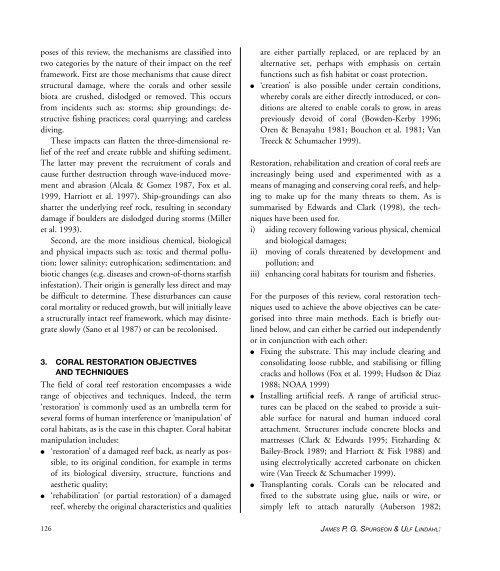You also want an ePaper? Increase the reach of your titles
YUMPU automatically turns print PDFs into web optimized ePapers that Google loves.
poses <strong>of</strong> this review, the mechanisms are classified into<br />
two categories by the nature <strong>of</strong> their impact on the reef<br />
framework. First are those mechanisms that cause direct<br />
structural damage, where the corals and other sessile<br />
biota are crushed, dislodged or removed. This occurs<br />
from incidents such as: storms; ship groundings; destructive<br />
fishing practices; coral quarrying; and careless<br />
diving.<br />
These impacts can flatten the three-dimensional relief<br />
<strong>of</strong> the reef and create rubble and shifting sediment.<br />
The latter may prevent the recruitment <strong>of</strong> corals and<br />
cause further destruction through wave-induced movement<br />
and abrasion (Alcala & Gomez 1987, Fox et al.<br />
1999, Harriott et al. 1997). Ship-groundings can also<br />
shatter the underlying reef rock, resulting in secondary<br />
damage if boulders are dislodged during storms (Miller<br />
et al. 1993).<br />
Second, are the more insidious chemical, biological<br />
and physical impacts such as: toxic and thermal pollution;<br />
lower salinity; eutrophication; sedimentation; and<br />
biotic changes (e.g. diseases and crown-<strong>of</strong>-thorns starfish<br />
infestation). Their origin is generally less direct and may<br />
be difficult to determine. These disturbances can cause<br />
coral mortality or reduced growth, but will initially leave<br />
a structurally intact reef framework, which may disintegrate<br />
slowly (Sano et al 1987) or can be recolonised.<br />
3. CORAL RESTORATION OBJECTIVES<br />
AND TECHNIQUES<br />
The field <strong>of</strong> coral reef restoration encompasses a wide<br />
range <strong>of</strong> objectives and techniques. Indeed, the term<br />
‘restoration’ is commonly used as an umbrella term for<br />
several forms <strong>of</strong> human interference or ‘manipulation’ <strong>of</strong><br />
coral habitats, as is the case in this chapter. <strong>Coral</strong> habitat<br />
manipulation includes:<br />
● ‘restoration’ <strong>of</strong> a damaged reef back, as nearly as possible,<br />
to its original condition, for example in terms<br />
<strong>of</strong> its biological diversity, structure, functions and<br />
aesthetic quality;<br />
● ‘rehabilitation’ (or partial restoration) <strong>of</strong> a damaged<br />
reef, whereby the original characteristics and qualities<br />
●<br />
are either partially replaced, or are replaced by an<br />
alternative set, perhaps with emphasis on certain<br />
functions such as fish habitat or coast protection.<br />
‘creation’ is also possible under certain conditions,<br />
whereby corals are either directly introduced, or conditions<br />
are altered to enable corals to grow, in areas<br />
previously devoid <strong>of</strong> coral (Bowden-Kerby 1996;<br />
Oren & Benayahu 1981; Bouchon et al. 1981; Van<br />
Treeck & Schumacher 1999).<br />
Restoration, rehabilitation and creation <strong>of</strong> coral reefs are<br />
increasingly being used and experimented with as a<br />
means <strong>of</strong> managing and conserving coral reefs, and helping<br />
to make up for the many threats to them. As is<br />
summarised by Edwards and Clark (1998), the techniques<br />
have been used for.<br />
i) aiding recovery following various physical, chemical<br />
and biological damages;<br />
ii) moving <strong>of</strong> corals threatened by development and<br />
pollution; and<br />
iii) enhancing coral habitats for tourism and fisheries.<br />
For the purposes <strong>of</strong> this review, coral restoration techniques<br />
used to achieve the above objectives can be categorised<br />
into three main methods. Each is briefly outlined<br />
below, and can either be carried out independently<br />
or in conjunction with each other:<br />
● Fixing the substrate. This may include clearing and<br />
consolidating loose rubble, and stabilising or filling<br />
cracks and hollows (Fox et al. 1999; Hudson & Diaz<br />
1988; NOAA 1999)<br />
● Installing artificial reefs. A range <strong>of</strong> artificial structures<br />
can be placed on the seabed to provide a suitable<br />
surface for natural and human induced coral<br />
attachment. Structures include concrete blocks and<br />
mattresses (Clark & Edwards 1995; Fitzharding &<br />
Bailey-Brock 1989; and Harriott & Fisk 1988) and<br />
using electrolytically accreted carbonate on chicken<br />
wire (Van Treeck & Schumacher 1999).<br />
● Transplanting corals. <strong>Coral</strong>s can be relocated and<br />
fixed to the substrate using glue, nails or wire, or<br />
simply left to attach naturally (Auberson 1982;<br />
126<br />
JAMES P. G. SPURGEON & ULF LINDAHL:


















